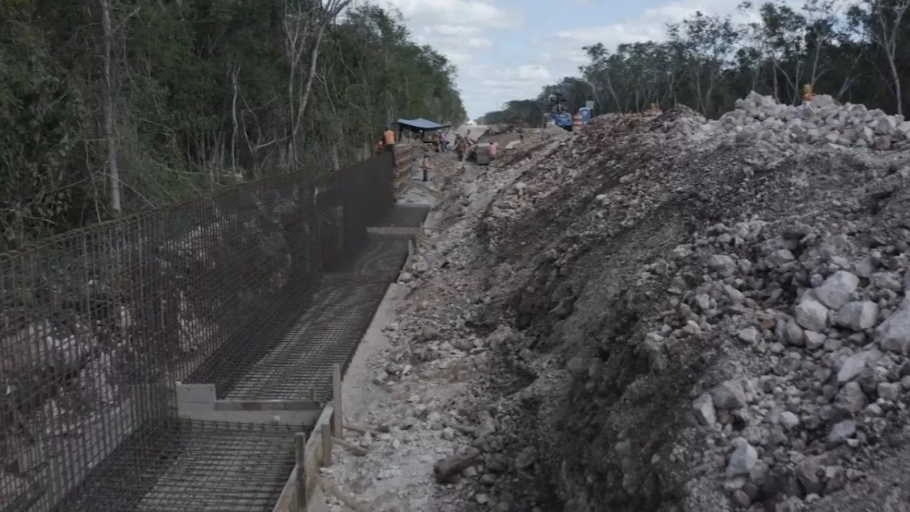
By Magadalena Gomez
The visit of the President of the Republic to the southeast last weekend to supervise the progress of the so-called Maya Train offered a twist that, although it’s not new, has, despite the fact that he kept his speech focused only on the train, now opened and formalized the proposal for re-zoning land use, if still opaque. It was his officials from the beginning who brought up the intention of developing that plan starting with the stations of the aforementioned train.
The reactions of indigenous organizations lie precisely in the impact on their culture and territories of the so-called development poles. For that they have resorted to filing lawsuits for protection (amparos) with varied results, including the most recent order for a definitive suspension that has not been complied with.
It was a tour of strategic presidential announcements. It’s not only the Maya Train, he acknowledged already, it’s also infrastructure development: the expansion of Puerto Progreso; the completion of a section of the gas pipeline that was needed to bring fluid to the peninsula from Tabasco, only two pumping plants are lacking; two combined cycle plants will be constructed, two thermoelectric, one in Mérida and another in Valladolid.
He also decided that in order to protect the work and to avoid temptations of privatization, the operation of sections 1, 6 and 7 of the Maya Train, as well as the Tulum, Chetumal and Palenque airports, in addition to the Santa Lucia airport, will be left to the armed forces through a company whose purpose is to finance the pensions of soldiers and sailors. And at the same time this will guarantee security in the region.
Lastly, he called on the governors of Tabasco, Chiapas, Campeche, Yucatán, and Quintana Roo to subscribe to the Southeast Land Management Program Agreement, which defines the rules for land use to avoid disorder and corruption and that respects urban development planning in the five states. President Andrés Manuel López Obrador and the UN-Habitat representative in Mexico signed as honorary witnesses. The secretaries of Environment and Natural Resources, National Defense, the Navy, Communications and Transportation, Territorial Agrarian and Urban Land Development, Tourism, the general director of the National Fund for Tourism Promotion were also witnesses for the federal government. The municipal president of Tulum was also a witness. The content of the agreement was not disclosed, it will be necessary to know the regulations for land use.
There were neither reports on the still-pending environmental impact statements, nor the current state of ejidal territories that will be affected, or negotiated, as they say. At this point it’s clear that the simulated consultation from a year ago is being deployed in some follow-up commissions with basically ejido authorities regarding the specific requests they made in the so-called forums. This is what they are concentrating the federal agencies on in order to “comply with them.”
At all the events on his tour, the head of the Executive insisted on the scope of the government’s commitment: “We must take care of the environment, we must take care of the flora and fauna, and we must also take care of the archaeological heritage. That’s precisely why the Maya Train is being made, to expose the greatness of Mayan culture, which developed and flourished in this region. It would be more than a contradiction to affect archaeological zones.” And once it’s finished and the train is operating, he pointed out that it would boost tourism a lot. All of this without mentioning the indigenous peoples, the historical guardians of their territories and culture.
That is indeed the great contradiction. Only two indirect references, when mentioning the train’s route he pointed out: “Ending there in Xpujil or at the limits of Quintana Roo, where there is a dispute that I hope will be resolved well.” And the second was the reiteration of the focus on the individual beneficiaries of the different social programs, indicating the respective figures at each event. That is the cornerstone of the policy of the so-called 4T: the indigenous people without their peoples. Perhaps that’s why there has been no response to the letter from six UN rapporteurs last September, headed by the rapporteur for Indigenous peoples, expressing grave and well-founded concerns about the so-called Maya Train project, given the impact on the peoples, as subjects of collective rights. That is the state of a project that goes simply because it goes, and which is accompanied by others. For now, in Huexca, Morelos, the community opposition is under such pressure that despite the legal protections they have achieved, the threat of starting operations of the thermoelectric plant is being carried out before offering justice for Samir Flores.
This article was originally published in Spanish by La Jornada on Tuesday, December 22, 2020. https://www.jornada.com.mx/2020/12/22/opinion/018a1pol This English interpretation by the Chiapas Support Committee and shared with Schools for Chiapas.
